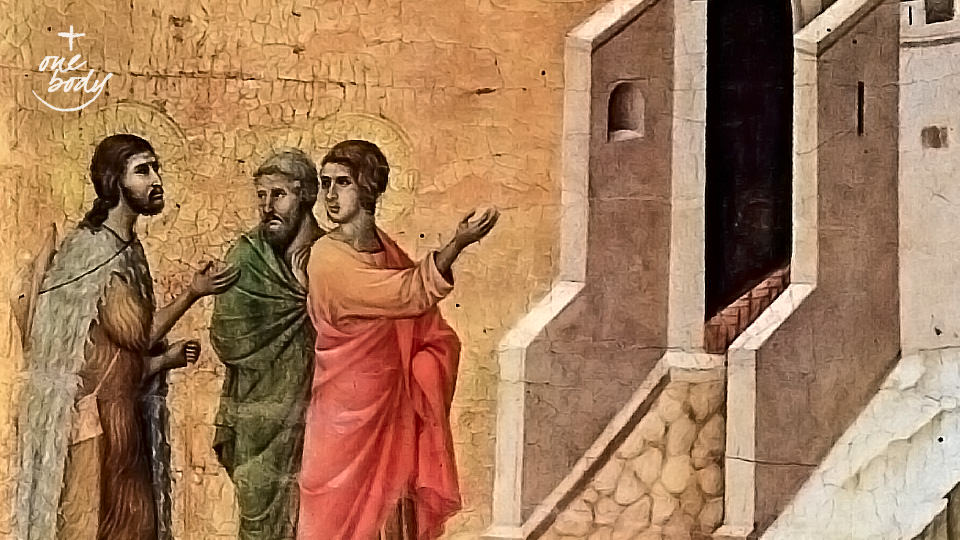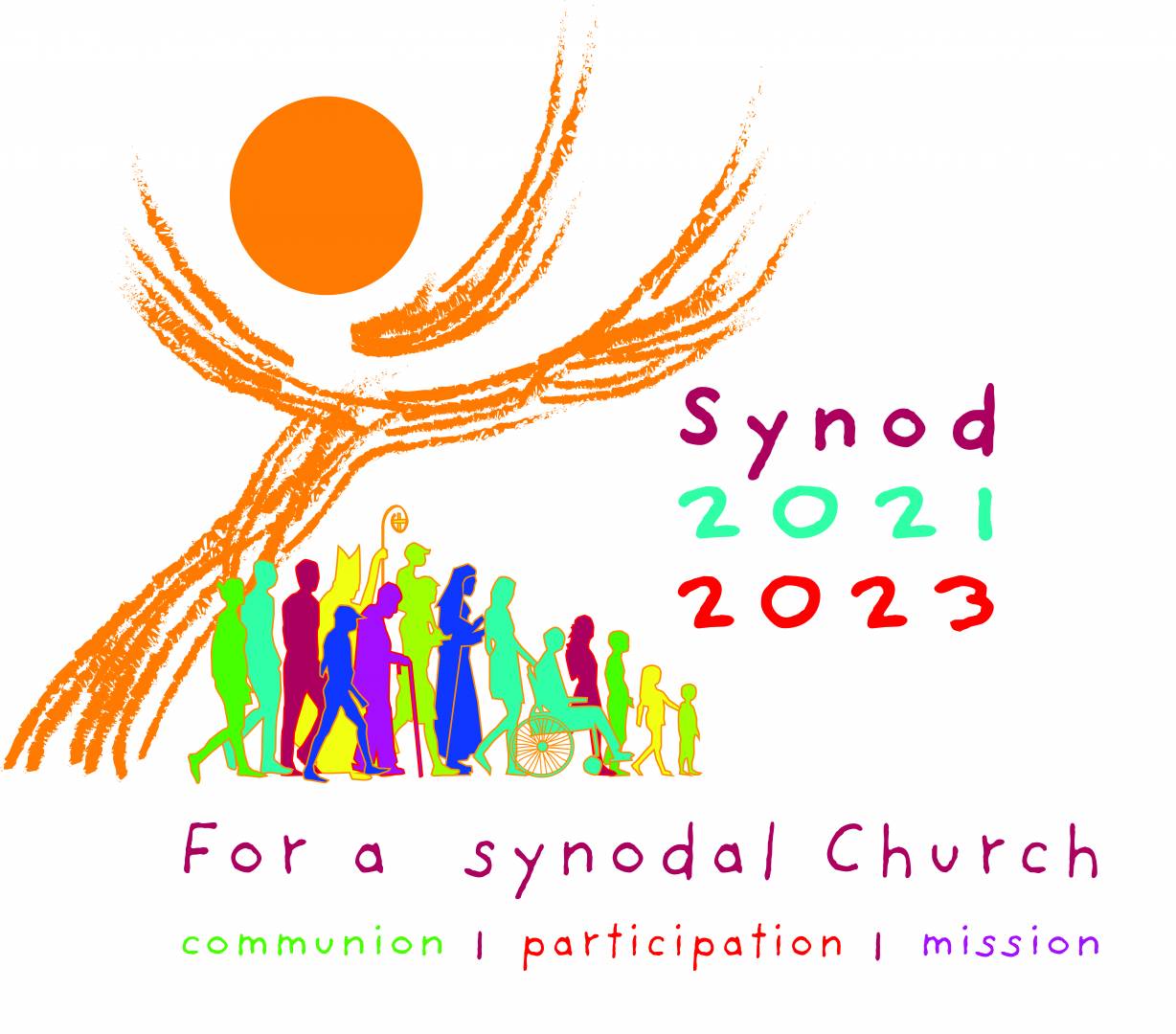

A primer on synodality | One Body
Nicholas Jesson
Wednesday, September 29, 2021

Detail of Road to Emmaus by Duccio di Buoninsegna (Source: Wikimedia Commons)
A primer on synodality
by Nicholas Jesson
 Synod comes from the Greek syn and odos (meaning “with” and “path”) and refers to a way of living or working together. My favourite biblical passage for synodality is that of the disciples on the road to Emmaus, where Cleopas and his companion are joined by the resurrected Jesus, who walks with them and explains the scriptures to them. The biblical passage ends with a meal in which they finally recognize him in the breaking of the bread. Synodality is about walking together in a shared search for Christ in scripture, prayer, and common life.
Synodality is “the specific modus vivendi et operandi of the Church, the People of God, which reveals and gives substance to her being as communion when all her members journey together, gather in assembly and take an active part in her evangelizing mission” (Synodality in the Life and Mission of the Church, no. 3).
Pope Francis has initiated a consultation process throughout the church, first in parishes and dioceses and then in national and regional bodies, culminating in the Synod of Bishops gathering in October 2023. During the diocesan phase, groups throughout the local church – parishes, deaneries, religious orders, schools, youth groups, seniors’ homes, mission teams, etc. – will reflect on a “fundamental question” about journeying together as a synodal church:
Synod comes from the Greek syn and odos (meaning “with” and “path”) and refers to a way of living or working together. My favourite biblical passage for synodality is that of the disciples on the road to Emmaus, where Cleopas and his companion are joined by the resurrected Jesus, who walks with them and explains the scriptures to them. The biblical passage ends with a meal in which they finally recognize him in the breaking of the bread. Synodality is about walking together in a shared search for Christ in scripture, prayer, and common life.
Synodality is “the specific modus vivendi et operandi of the Church, the People of God, which reveals and gives substance to her being as communion when all her members journey together, gather in assembly and take an active part in her evangelizing mission” (Synodality in the Life and Mission of the Church, no. 3).
Pope Francis has initiated a consultation process throughout the church, first in parishes and dioceses and then in national and regional bodies, culminating in the Synod of Bishops gathering in October 2023. During the diocesan phase, groups throughout the local church – parishes, deaneries, religious orders, schools, youth groups, seniors’ homes, mission teams, etc. – will reflect on a “fundamental question” about journeying together as a synodal church:
“How is this ‘journeying together’ happening today in your local Church? What steps does the Spirit invite us to take in order to grow in our ‘journeying together’?” (For A Synodal Church: Communion, Participation, and Mission, no. 26. *Note: This is the Preparatory Document for the 2021-2023 synod on synodality. For the sake of simplicity, all further references to this document are abbreviated PD.)Church history has numerous examples of local synods, similar to ecumenical councils but with lesser importance or authority. Following Vatican II, Pope Paul VI re-instituted the permanent Synod of Bishops in Rome, which now meets at the invocation of the pope. The Code of Canon Law even includes provisions for convening diocesan, national, and regional synods for consultation with the whole people of God. In each of these examples, however, “synod” is an institutional and juridical concept. Pope Francis’ call for a more synodal church reminds us of the Vatican II understanding of the church as communion. Cardinal Robert Bellarmine famously described the church as a perfect society instituted by Christ with a visible order and hierarchical authority. In the Catholic polemic against 16th-century Protestants, Bellarmine’s vision of the church contrasted with the Reformation’s diverse – and at times disorderly – churches. Over the centuries, the institutional view of the church grew to emphasize clerical and papal authority with a corresponding diminishment of lay responsibility. This culminated in the ultramontanist centralization of papal power at the First Vatican Council in 1870. Theological reflection on the church was almost indistinguishable from ecclesiastical polity or canon law until Pope Pius XII’s encyclical Mystici Corporis Christi in 1943, which drew upon the Pauline image of the body of Christ. It was only with the 20th-century ressourcement in historical, archaeological, biblical, and liturgical studies that Catholic theology emerged with a modern reformed view of the church at the Second Vatican Council. In contrast to Bellarmine’s perfect society, the 20th-century renewal movements drew attention to biblical images like the body of Christ, people of God, vine, servant, herald, or communion of saints. Avery Dulles’ classic work Models of the Church outlines six models, arguing that none are sufficient though together they illuminate certain essential aspects of the church. Central to Vatican II’s reflection were the theological themes of koinonia (or communion) and sacrament. Theologians such as Edward Schillebeeckx identified the church as a sacrament – a visible sign instituted by Christ that brings grace. Christ himself is the primordial sacrament, so the church as body of Christ is a sacrament of salvation for the world.
“Since the Church is in Christ like a sacrament or as a sign and instrument both of a very closely knit union with God and of the unity of the whole human race, it desires now to unfold more fully to the faithful of the Church and to the whole world its own inner nature and universal mission.” (Lumen Gentium, no. 1)Woven throughout the Council’s teaching on the church in Lumen Gentium, Unitatis Redintegratio, and other documents was an understanding of the church as a reflection of the communion between the Trinitarian persons, Father, Son, and Spirit. Consistent with the understanding of the church as sacrament, the “church as communion” is integrally related to the rich Eucharistic themes of the same Council documents. In ecumenical dialogue about the nature and mission of the church, considerable agreement has been found on an ecclesiology of koinonia/communion. [See for example the World Council of Churches’ convergence text The Church: Towards a Common Vision; as well as ARCIC II, The Church as Communion (1990); Methodist-Roman Catholic International Commission, The Grace Given You in Christ (2006); U.S. Lutheran-Roman Catholic Dialogue, The Church as Koinonia of Salvation (2004); Orthodox-Roman Catholic Dialogue, The Mystery of the Church and of the Eucharist in the Light of the Mystery of the Holy Trinity (1982); Ecclesiological and Canonical Consequences of the Sacramental Nature of the Church. Ecclesial Communion, Conciliarity and Authority (2007) and Synodality and Primacy During the First Millennium (2016); Catholic-Pentecostal International Dialogue, Perspectives on Koinonia (1989); and Evangelical-Roman Catholic International Consultation, Church, Evangelization, and the Bonds of Koinonia (2002).] Nearly half a century after the Council, we are still discovering new riches in the Vatican II teaching, such as those highlighted by Pope Francis in his call for a church that is more synodal. The synod theme of “Communion, Participation, and Mission” points to the critical elements of synodality, rooted in the theology of communion. It should come as no surprise to anyone that Pope Francis has framed the Synod as listening to the cry of the poor and reaching out to those on the margins. This mission to the peripheries is coupled with our repentance for systemic sins deeply rooted in our ecclesial culture.
“The whole Church is called to deal with the weight of a culture imbued with clericalism that she inherits from her history, and with those forms of exercising authority on which the different types of abuse (power, economic, conscience, sexual) are grafted.” (PD, no. 6)The General Secretariat of the Synod of Bishops has issued two very detailed documents to assist local churches in listening and discernment. The first, a Preparatory Document, contains a theological reflection on synodality that is essential reading. The second text, a Vademecum (or handbook), is intended for those leading the consultation process in the diocesan phase from October 2021 to April 2022. Although this latter document deals with various practicalities, it is intended to facilitate a free consultation that listens to the Spirit “who like the wind ‘blows where it wills; you can hear the sound it makes, but you do not know where it comes from or where it goes’ (Jn 3:8), remaining open to the surprises that the Spirit will certainly prepare for us along the way” (PD, no. 2).
“The ability to imagine a different future for the Church and her institutions, in keeping with the mission she has received, depends largely on the decision to initiate processes of listening, dialogue, and community discernment, in which each and every person can participate and contribute.” (PD, no. 9)The International Theological Commission describes synodality as a “constitutive dimension of the church” meaning that synodality is essential to building the Christian community. The style with which the church ordinarily lives and works is “the community listening to the Word and celebrating the Eucharist, the brotherhood of communion and the co-responsibility and participation of the whole People of God in its life and mission, on all levels and distinguishing between various ministries and roles” (PD, no. 27).
“A Church capable of communion and fraternity, of participation and subsidiarity, in fidelity to what she proclaims, will be able to stand beside the poor and the least and lend them her own voice.” (PD, no. 9)In the first millennium, the church was more consciously synodal in its practices and sense of identity. The Preparatory Document cites Saints Cyprian of Carthage, Augustine of Hippo, and John Chrysostom, who, each in their different circumstances, saw the church realized in the communion of all the baptized. In the early centuries, synodal praxis developed at all levels of the church, culminating in the ecumenical councils. As Pope Francis noted in Evangelii Gaudium, alongside the ecumenical council and synods, with an appeal to the authority of the sensus fidei of the whole people of God, the popes of the day consulted the bishops to know the faith of the whole church (PD, no. 11). In Vatican II’s renewed understanding of the church, the whole people of God are united in baptism and called together to be participants in Christ’s priestly, prophetic, and kingly ministry. The sensus fidei is the supernatural discernment of the entire people of God, which “cannot err in matters of belief” when, under the guidance of the Spirit, the faithful demonstrate universal agreement in matters of faith and morals.
“This People, gathered together by its Pastors, adheres to the sacred deposit of the Word of God entrusted to the Church, perseveres constantly in the teaching of the Apostles, in fraternal communion, in the breaking of bread, and in prayer, ‘so that holding to, practicing, and professing the heritage of the faith, it becomes on the part of the Bishops and Faithful a single common effort.’” (PD, no. 13)In this understanding, synodality describes a pluriform experience of listening to the Spirit and gathering the insights of all of the faithful into collective decisions. Like any work of the Spirit, synodal discernment withers and dies in structures and institutions that limit participation and creative freedom. Bishops should not be afraid to listen to the people. Synodal consultation does not imply adopting democratic principles in which majority opinions prevail but rather a shared passion for the church’s mission of evangelization. Within the hierarchically structured community, the sensus fidei of the people of God allied with the magisterial function of the bishops expresses itself in the unanimous consensus of the whole church.
“In order to ‘journey together,’ we need to let ourselves be educated by the Spirit to a truly synodal mentality, entering with courage and freedom of heart into a conversion process that is indispensable for the ‘continual reformation of which [the Church] always has need, in so far as she is a human institution.’” (PD, no. 9)As Pope Francis has invited us into a synodal process over the next three years, it is imperative that every level of the church engage fully in this discernment. The synod consultation is intended to include the whole people of God and thus engage the sensus fidei in reflecting on the fundamental question posed about how synodality is exercised in the local church. For the 50th anniversary of Vatican II, the Catholic bishops of Canada issued a document series entitled “A Church in Dialogue”: Towards the restoration of unity among Christians, Catholic Ecumenical Commitment, Catholics and Muslims in Canada: Believers and Citizens in Society, and The Catholic Church and Interreligious Dialogue. These four teaching documents begin with the observation that one of the constitutive dimensions of the church is to be in dialogue with the Spirit, with the church itself, with various communities within the church, with other Christians, with other religions, with politics, culture, philosophy, and science. This is sometimes described as the ecclesia ad intra and the ecclesia ad extra. A similar observation is made in the Preparatory Document for the Synod, which identified two perspectives in the synodal process: to look at the internal life of the church itself and to consider our relations, dialogue, and common initiatives with believers of other religions, with people distant from the faith, and with specific groups in the wider world. These two perspectives must be kept together as we reach out to engage all within the synodal process.
Nicholas Jesson is the ecumenical officer for the Archdiocese of Regina, former ecumenical officer for the Diocese of Saskatoon, and former executive director of the Prairie Centre for Ecumenism. He is a member of the Roman Catholic-United Church of Canada Dialogue, editor of the Canadian Council of Churches’ Margaret O’Gara Ecumenical Dialogues Collection, and editor of the Anglican-Roman Catholic Dialogue archive IARCCUM.org.

Click here for all articles in the One Body series
Related Articles:
<<













